
Sunday, 7 July 2013
Distance 28 km
Duration 6 hours 0 minutes
Ascent 281 m, descent 252 m
Map 170 of the TOP 100 lime-green series
Once again we rose before the sun. The ablutions block was being energetically cleaned by a girl in singlet and shorts, but nobody else was awake.
We left at about 6:45, back past the great square bulk of the church of Ste-Cécile, which was founded in the tenth century but has been much altered since.

It stood in a field of vines, as it had no doubt done throughout its history, the vines having already been there for a thousand years by the time it was built (a Gallo-Roman wine-making settlement has been excavated nearby).
There was a morgue-like stillness in the village at this hour, and it was therefore a surprise to see a bar with its doors already flung open and tables arranged invitingly on the road outside.
We were their first customers and probably their most appreciative for the day. As we had just had muesli, we confined ourselves to coffee in the hope of getting pastries later.
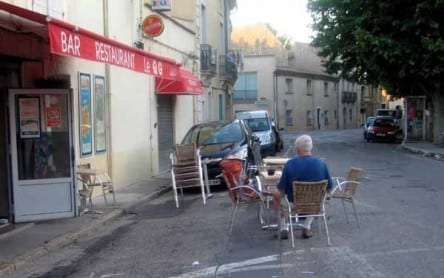
The road that we needed went off beside the bar, into the vines, and curved down the slope before crossing under the A9.
Then we turned hard left and scrambled up the bank onto a dusty track which rose and fell as it meandered through verdant fields and dry grassland alternately.

We were still close to the autoroute and went past a well-fenced rest area full of heavy vehicles, whose drivers seemed to be all still asleep
Then the track suddenly angled away from the A9 and set off across the landscape in an uncompromising straight line. We recognised the hand of the Romans. Before long there was a marker confirming that we were indeed back on the Voie Domitienne.

This was the first Roman road in France. It came over the Alps near Briançon, then followed the Durance river into Provence, crossed the Rhône, passed through Nîmes and Montpellier, and ended at Narbonne, where it joined the Via Aquitania coming down from Bordeaux.
However, like the Régordane, it was already a well-used road before the invading Romans took it over in about 120 BC (indeed, it seems to have been the route that Hannibal took, a hundred years earlier). The Gauls themselves were great road-builders and had a network of straight roads aligned with sunrise of the summer solstice. This was part of their religion. The Romans merely took them over, paved them and set up way stations at intervals of a day’s travel, about 30 km.

A few kinks had crept into the Via Domitia in the subsequent couple of thousand years, but fundamentally it plunged across the land as if drawn by a ruler.
Most of it was along an airy ridge carpeted in vines. There was one deviation caused by a field of corn, but we were soon back on the true line.
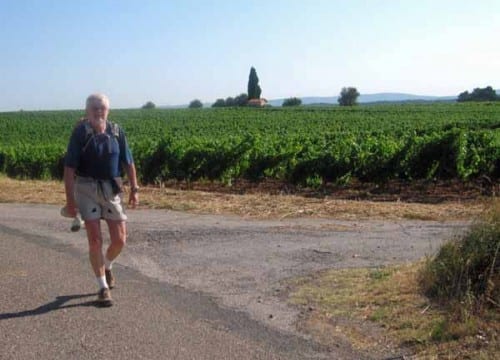
Being the comfort-loving creatures that we are, we turned off after a while on a small descending bitumen road and crossed back under the autoroute, in order to visit the village of Pinet, where there was hope of a bar.
At the edge of the houses we met an old man on a bicycle, his face deeply rutted and browned by the sun, who told us that there was a bar but it might be closed on Sunday.
We pressed on hopefully and were rewarded with the sight of an open bar and a boulangerie, face to face across the narrow street. The terrace of the bar was jammed into an alley between two buildings.

We sat down gleefully for our second breakfast, starting with a jug of ice-cold water and moving on to coffee, with pastries from across the way which were delightful.
While we were sitting there, we saw someone that we knew – the workman with the hose who had spoken to us in Poussan the day before. He stopped for a brief conversation, but did not seem as inclined to chat on his own time as he had been on the council’s. He said that he actually lived here in Pinet, although he worked in Poussan.
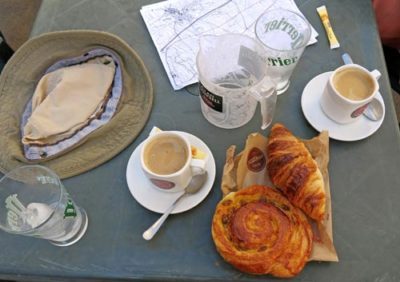
When we had finished, it was ten o’clock and the heat was building up.
We set off to rejoin the Voie Domitienne, which by then seemed to consist of two converging strands. We took the nearer, which was as straight and narrow as the other one, but had a lick of bitumen.

There were almond trees here and there beside the road, apparently a tradition going back to the Romans. When the two strands joined, we continued until we crossed the D32E, at which point the Roman road became no more than a farm track.

Nevertheless we took it, as we knew that there was a footbridge over the Hérault river, straight into the village of St-Thibéry, which was our destination for the day.
It was now midday and the sun drilled down mercilessly as we trudged across the flat, green but treeless land. The track forded a small stream, where there was a letterbox incongruously dangling from a bush, and then it turned, for the first time in hours, and we found ourselves amongst fields of wheat and vegetables.
After a while these gave way to acres of closely cropped turf, presumably to be sold as instant lawn.
We turned again and arrived at the farmhouse that was marked on the map, behind which was the bridge. There was no sign of life, apart from a dog on a chain, so we went around to the back, where the Hérault river was hidden by a mass of vegetation.

The bridge was a sorry sight – its steps rusty, choked with brambles and falling apart. Signs warned that it was forbidden to use it, not that anyone could, as it was barricaded at both ends by thick steel sheets. We did try but it was beyond us.
The depressing alternative was at least ten extra kilometres – back to the D32E, along to the road bridge and up the other side. We could see people picnicking in the park a few metres away over the river, and we even considered swimming, but the bank was a cliff covered with impenetrable blackberries. Then there was the matter of how to keep our packs dry.
We turned back past the farmhouse with dragging footsteps. We were tired, hot, disappointed, short of water and facing a two-hour road bash in the hottest part of the day.
Just then a car drove up along the dirt road and stopped. It contained the owners of the farm and the woman launched into a torrent of abuse at our trespassing on their land. I said we did not know it was private property but she remained hostile. Then the man offered to bring us some water, and they drove on.

Soon he reappeared with the water, but without his wife, and invited us conspiratorially to get in the car. He would drive us around to the village, he said. We got the feeling that he would be in trouble if his wife found out.
Hardly able to believe what was happening, we were whisked back to the main road. As we passed the letter box at the ford, he said that his property started there, and that he really should put up a sign warning people that it was private, and that the bridge was closed.
We drained the big bottle of cold water in the few minutes that it took to reach the other bridge and cross it. Our saviour set us down at the entrance to the old railway line, and we wrung his hand passionately as we parted.

The actual railway line was barricaded off, but there was a tiny road beside it, shaded by an arching canopy of trees, so it was a pleasure to walk on.
Before long we came to an astonishing sight – the ruins of the original bridge on the Via Domitia. Three of the arches were still standing after centuries of neglect, testament to the skill of the Roman engineers.

After that it was only about a kilometre until our little road parted company with the railway line and we found ourselves in the park that we had gazed at so longingly from the other side of the river. It was still full of picnickers as we walked over to the offending bridge and climbed up a few rungs as a symbolic substitute for having crossed it.
To get to the camping ground we had to make our way through a warren of streets in the old town. It was fascinating and confusing, but it was too hot to do it justice. We were only interested in possible restaurants, of which there seemed very few. Eventually we came to the old railway line again, curving around the edge of the town, and went under it onto the big road (Route de Bessan) that headed off to the south.
The camping ground was some distance away, in an industrial area just off a roundabout, and we had difficulty finding the entrance, but after struggling through a hedge or two we got there.

Naturally the office was closed, but there were holiday makers on all sides, lounging outside their bungalows and vans, playing boules or sunbathing beside the pool while their children shrieked and played in the water.
There was also a large, elegant looking restaurant, which we immediately decided to eat at that evening.
We chose a pleasant spot under a mulberry tree with thick, soft grass, but the ripe fruit on the ground stained our mattresses so we moved to a different tree. We were too tired to have lunch – all we needed was a shower and a sleep.
The afternoon passed quickly in these restful surroundings. Conscious that we had not paid, we went several times to the office, but it was never open. A gardener working nearby told us to come back at 6 pm, which we did, but to no avail.

As evening approached we wandered down to the restaurant, which was a pleasant new building in the old style, and sat at a terrace table with our drinks, under a broad white canopy.
Tables were set for dinner and presently we moved across and occupied one of them. The middle-aged waitress was delighted to meet some Australians, as she had a daughter who had studied there for a year.
We chose the menu for €14, which started with elaborate salads, one with seafood and the other with ham and chicken. They were both delicious but we had room for more, having not had lunch.
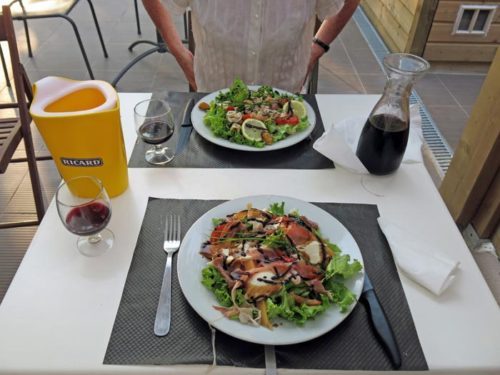
For our main dishes, we had an entrecôte with a pile of courgettes, and a lasagne. They were substantial, but not even half the size of the intimidating ones we had been served at St-Gilles.
On this occasion we managed to finish them, along with all the bread and wine on the table.
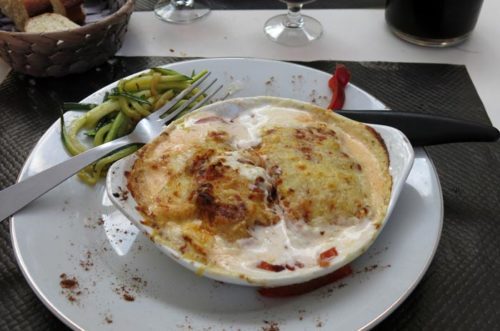
For dessert, Keith had a piece of chocolate cake and I asked for coffee, but the machine was broken so I settled for a coffee ice-cream.
On our way back to the tent we called in at the office, but as ever it was closed, and the entry gates had also been shut and locked.
Previous day: Fabrègues to Loupian